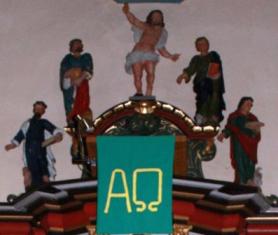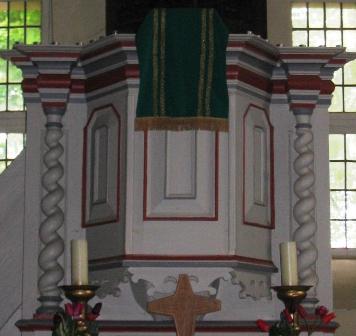A Baroque View on the Parish of Ducherow
The origin of churches in the parish Ducherow
The area around Ducherow was settled in the 13th century, that’s why the oldest churches were built during the late Middle Ages. Nevertheless, all churches changed their appearance through the decades, because of fire and acts of war. For example the church of Kagendorf burnt down in 1657 and was rebuilt 11 years later. During the 18th century, a western portal and tower were added. The church of Ducherow was badly damaged in the course of the Thirty Years’ War and not renovated until 1718. The churches from Rathebur and Rossin were structurally renewed during the 17th century.
Pulpit altars
The churches of Ducherow, Rathebur, Löwitz and Rossin have a pulpit altar. After the Reformation at the beginning of the 16th century, churches were equipped with pulpits. Now, the sermon of the pastor was in the center of the liturgy. Furthermore, the choir is quite small; thus the pulpit altar connected two important elements during the church service. This enabled the audience to sit beside the altar.

Ducherow
In 17th century, the village Ducherow was destroyed during the Polish-Swedish War from 1655-1660. The church was rebuilt in the Baroque period. The roof, the bandings on the plaster and the isochromatic window surroundings are typical for this phase.
The baroque pulpit and altar were redesigned and connected in the 19th century, so that more people can join the church service. Anyway, the Moses-figure, which carried the altar, is now exhibited in Züssow and the altarpiece is gone, but the pulpit altar symbolizes Ducherow’s baroque heritage. The polygonal pulpit is framed by two Corinthian columns, made of marble, ornamented with elaborated tendrils. The pictures of the savior and the two evangelists are probably made in the 19th century. The backside of the altar is decorated with the four evangelists Matthew, Mark, Luke, John and Jesus in the middle (from left to right). Under the pulpit-ceiling we see the Holy Spirit, symbolized by a white dove.

Rathebur
The church was redesigned during the 20th century. Nevertheless, the timber-framed gable, which was constructed in the 17th century, is still the original one.
The plain interior is very functional designed. In contrast to this, the typical baroque Ecce-Homo image, fixed under the pulpit ceiling and was made by H. Eisfeld. The epitaph was constructed in 1711.

Rossin
The church, built on boulders, got a new rooftop in the year 2000. The windows and the inward-sloping pillars were already changed during the 17th century.
Inside, there is a western gallery, which was built one century later. The epitaph, made of sandstone and ornamented with two cherubs and the coat of arms of Carolina Gustava von Cammen, was constructed during the same period.
The plain altar from 1771 has a curved pulpit with acanthus ornaments on its sides. The pilasters on each side were painted with an authentic marbling.
Schmuggerow
The neo-Romanesque church has a tower, which was completed in the 19th century and was made of boulders. Nevertheless, there are some traces of the baroque period in the interior: The retable, located on the southern wall, was constructed in 1710 according to the plans from Hans Jürgen Köppern and his wife. The picture of the Last Supper, attached at retables center was painted in 1725. Beside this, there are two Corinthian columns with carved apostles. The pedestals show the crests of Köppern and Lewetzow.

Löwitz
The plastered church was also built of boulders and completed in 1620. The frame-work tower with walled bricks, made in the 19th century, is under construction at the moment. The windows are designed with basket handled arches and are, like the western portal, made in the same period.

Kagendorf
The original church in Kagendorf was already built during the late Middle Ages. However, due to a big fire, the largest part of the church has its origin in the 17th century. In consequence, the pulpit, decorated with some figures, was built in 1669. But besides, the late baroque retable with its Corinthian columns and the acanthus decorations was finished in 1786. While the organ is from 1883, the seats of the Churches patrons and the pastor preacher date to the 18th century. Also, some additions, like the western portal, were finished during the same period.
